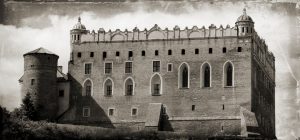 Remarkable for its architecture and mysterious atmosphere, the 14th century Teutonic Castle constitutes a major draw for visitors for the town of Golub-Dobrzyn. Famous international knights’ tournaments are held here yearly in July. Besides the castle, also of interest are the remains of mediaeval walls with towers and a moat, plus several other historic monuments. The region around the town is rich in lakes and forests, which allows for various recreational activities.
Remarkable for its architecture and mysterious atmosphere, the 14th century Teutonic Castle constitutes a major draw for visitors for the town of Golub-Dobrzyn. Famous international knights’ tournaments are held here yearly in July. Besides the castle, also of interest are the remains of mediaeval walls with towers and a moat, plus several other historic monuments. The region around the town is rich in lakes and forests, which allows for various recreational activities.
Doubtlessly, Golub-Dobrzyn is a town attractive to tourists. Registered in the list of historic monuments, the most important sights in the town include: the Castle, the Old Town, defensive walls, Gothic Church of St. Catherine and “Dom Pod Kapturem” (“Under the Hood House”) from the 18th century.
After it had been returned to Poland in 1466 (the Second Torun Treaty), the Castle in Golub-Dobrzyn served as the seat of Anna Vasa, a royal princess. In a charming setting on a hill, it still has a fine interior and today it is home to several small museums, two of which showcase marquetry and armour from the battle of Grunwald in 1410. During your guided tour you will enjoy the private, alluring atmosphere of the Castle, and you should not miss the unusual alcove where wishes are supposed to come true. Each July, on the lawns surrounding the Castle, audiences observe medieval jousting tournaments by knights from a number of European countries, dressed in period costume.
In the vicinity of Golub-Dobrzyn there are some sites worth visiting: Plonne and Gora Modrzewiowa (Larch Hill), Szafarnia and the Chopin Centre, Obory and the Virgin Mary’s Sanctuary, renowned for its miracles, as well as other centres of recreation in Okonin and Grodno.
Golub-Dobrzyn is a town in central Poland, located in the heart of a county forming part of the Kuyavian-Pomeranian Voivodship. It covers 750 hectares and has a population of 13,754. Situated 42 km east of Torun (if you consider whether to visit Torun, it’s definitely worth it!), Golub-Dobrzyn enjoys a picturesque location straddling the Drweca River.
Prior to 1951 two towns existed on the site, but to understand why it is necessary to understand the history of Golub and Dobrzyn individually.
The first mention of Golub can be found in a document from 1258. In its infancy, it was a village inhabited by Poles, and then the Teutonic Knights erected a castle in the years 1296-1306 and Golub achieved town status. All the town rights were confirmed by Grand Master Michael Kuchmeister von Sternberg in the year 1421.
The wars in 1414 and 1422 resulted in serious damage being done to Golub. Later, in 1466, the town became part of Poland as a result of a peace treaty made in Torun.
Golub reached the peak of its development under the reign of King Sigismund III Vasa (1611-1625). Then came the period of the Polish-Swedish Wars, during which the town suffered great destruction, particularly between 1626 and 1629, as well as in 1660. It was also affected by the subsequent Seven Years’ War of 1756-1763.
During the first partition of Poland in 1772, the town was annexed by the Kingdom of Prussia. From 1807 to 1815 Golub remained part of the Duchy of Warsaw, in 1815 it was assigned to the Duchy of Poznan and in 1817 to West Prussia. Following the inclusion of the town as part of Imperial Germany in 1871, a policy of Germanisation was implemented in Golub and its vicinity.
In January 1920, the town was finally returned to Poland, yet in August the same year it was attacked by the Red Army. In 1939 Golub was annexed by Nazi Germany.
HISTORY OF DOBRZYN
The name Dobrzyn was initially given to a settlement established on the left bank of the Drweca in the second half of the 17th century. In 1684, Zygmunt Dzialynski called the settlement “Przedmiescie Golubskie” (“Suburb of Golub”), but in 1789 Count Ignacy Dzialynski founded the town of Dobrzyn there. In 1793, following the second partition of Poland, Dobrzyn was annexed by the Kingdom of Prussia. Between 1807 and 1815 it existed as part of the Duchy of Warsaw. In 1815, the town became part of the Kingdom of Poland in personal union with the Russian Empire. In the second half of the 19th century, after the Kingdom of Poland had been assigned to Russia, Dobrzyn started to develop rapidly and ultimately became larger than Golub.
The town became part of the Second Polish Republic in 1918, following the end of the First World War. In August 1920, Dobrzyn was attacked by the Soviet Army and in 1939 was annexed by Nazi Germany.